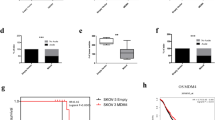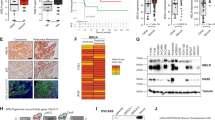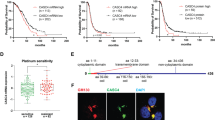Abstract
Peritoneal dissemination is the most frequent progression pathway of ovarian cancer and is therefore a key step to improve the prognosis. NK4, a large part of the α-chain of hepatocyte growth factor, is known to inhibit cancer cell migration. To characterize the function of NK4 and investigate its potential role in gene therapy of ovarian cancer, we introduced NK4 cDNA to an ovarian cancer cell line HRA and investigated its effects both in vitro and in vivo. HRA cells were transfected with either NK4 or luciferase-expression plasmids. After selection, NK4-expressing HRA cells (HRA/NK4) and the control cells (HRA/LUC) were obtained. NK4 was detected in the culture supernatant of HRA/NK4 by Western analysis. Migration capabilities of the cells were evaluated in vitro by scratch wound healing assay. The number of migrated cells was significantly smaller in the HRA/NK4 cultures than that in the control cultures (HRA or HRA/LUC). Also, the culture supernatant of HRA/NK4 significantly suppressed migration of control cells. This suppressive effect was observed when NK4-expressing cells were mixed with control cells at the ratio of 25% or more. In the in vivo experiments, HRA transfectants were injected intraperitoneally. The number of intraperitoneal tumors of HRA/NK4 was much smaller than that of control. In mice injected with HRA/NK4, ascites formation was suppressed and the survival was significantly prolonged. These findings suggest that NK4-mediated gene therapy can improve the prognosis of ovarian cancer by suppressing peritoneal dissemination. Gene Therapy (2001) 8, 1450–1455.
This is a preview of subscription content, access via your institution
Access options
Subscribe to this journal
Receive 12 print issues and online access
$259.00 per year
only $21.58 per issue
Buy this article
- Purchase on Springer Link
- Instant access to full article PDF
Prices may be subject to local taxes which are calculated during checkout








Similar content being viewed by others
References
Landis SH, Murray T, Bolden S, Wingo PA . Cancer statistics, 1999 CA Cancer J Clin 1999 49: 8–31
McGuire WP et al. Cyclophosphamide and cisplatin compared with paclitaxel and cisplatin in patients with stage III and stage IV ovarian cancer N Engl J Med 1996 334: 1–6
Roszkowski P, Wronkowski Z, Szamborski J, Romejko M . Evaluation of selected prognostic factors in ovarian cancer Eur J Gynaecol Oncol 1993 14: (Suppl.) 140–145
Heintz AP . Surgery in advanced ovarian carcinoma: is there proof to show the benefit? Eur J Surg Oncol 1988 14: 91–99
Date K et al. HGF/NK4 is a specific antagonist for pleiotrophic actions of hepatocyte growth factor FEBS Lett 1997 420: 1–6
Date K et al. Inhibition of tumor growth and invasion by a four-kringle antagonist (HGF/NK4) for hepatocyte growth factor Oncogene 1998 17: 3045–3054
Jiang WG et al. Antagonistic effect of NK4, a novel hepatocyte growth factor variant, on in vitro angiogenesis of human vascular endothelial cells Clin Cancer Res 1999 5: 3695–3703
Hiscox S et al. Inhibition of HGF/SF-induced breast cancer cell motility and invasion by the HGF/SF variant, NK4 Breast Cancer Res Treat 2000 59: 245–254
Parr C et al. Nk4, a new HGF/SF variant, is an antagonist to the influence of HGF/SF on the motility and invasion of colon cancer cells Int J Cancer 2000 85: 563–570
Matsumoto K, Date K, Shimura H, Nakamura T . Acquisition of invasive phenotype in gallbladder cancer cells via mutual interaction of stromal fibroblasts and cancer cells as mediated by hepatocyte growth factor Jpn J Cancer Res 1996 87: 702–710
Nakamura T, Matsumoto K, Kiritoshi A, Tano Y . Induction of hepatocyte growth factor in fibroblasts by tumor-derived factors affects invasive growth of tumor cells: in vitro analysis of tumor-stromal interactions Cancer Res 1997 57: 3305–3313
Bussolino F et al. Hepatocyte growth factor is a potent angiogenic factor which stimulates endothelial cell motility and growth J Cell Biol 1992 119: 629–641
Grant DS et al. Scatter factor induces blood vessel formation in vivo Proc Natl Acad Sci USA 1993 90: 1937–1941
Nakamura T et al. Molecular cloning and expression of human hepatocyte growth factor Nature 1989 342: 440–443
O'Reilly MS et al. Angiostatin: a circulating endothelial cell inhibitor that suppresses angiogenesis and tumor growth Cold Spring Harb Symp Quant Biol 1994 59: 471–482
O'Reilly MS et al. Endostatin: an endogenous inhibitor of angiogenesis and tumor growth Cell 1997 88: 277–285
Cao Y et al. Expression of angiostatin cDNA in a murine fibrosarcoma suppresses primary tumor growth and produces long-term dormancy of metastases J Clin Invest 1998 101: 1055–1063
Nguyen JT et al. Adeno-associated virus-mediated delivery of antiangiogenic factors as an antitumor strategy Cancer Res 1998 58: 5673–5677
Blezinger P et al. Systemic inhibition of tumor growth and tumor metastases by intramuscular administration of the endostatin gene Nat Biotechnol 1999 17: 343–348
Matsuda KM et al. A novel strategy for the tumor angiogenesis-targeted gene therapy: generation of angiostatin from endogenous plasminogen by protease gene transfer Cancer Gene Ther 2000 7: 589–596
Kuba K et al. HGF/NK4, a four-kringle antagonist of hepatocyte growth factor, is an angiogenesis inhibitor that suppresses tumor growth and metastasis in mice Cancer Res 2000 60: 6737–6743
Kay MA et al. Evidence for gene transfer and expression of factor IX in haemophilia B patients treated with an AAV vector Nat Genet 2000 24: 257–261
Kikuchi Y et al. Establishment of a human ovarian cancer cell line capable of forming ascites in nude mice and effects of tranexamic acid on cell proliferation and ascites formation Cancer Res 1987 47: 592–596
Urabe M et al. A novel dicistronic AAV vector using a short IRES segment derived from hepatitis C virus genome Gene 1997 200: 157–162
Wigler M, Pellicer A, Silverstein S, Axel R . Biochemical transfer of single-copy eucaryotic genes using total cellular DNA as donor Cell 1978 14: 725–731
Laemmli UK . Cleavage of structural proteins during the assembly of the head of bacteriophage T4 Nature 1970 227: 680–685
Tamura M et al. Inhibition of cell migration, spreading, and focal adhesions by tumor suppressor PTEN Science 1998 280: 1614–1617
Acknowledgements
This work was supported in part by grants from the Ministry of Health, Labor and Welfare of Japan, and the Ministry of Education, Culture, Sports, Science and Technology of Japan.
Author information
Authors and Affiliations
Rights and permissions
About this article
Cite this article
Saga, Y., Mizukami, H., Suzuki, M. et al. Expression of HGF/NK4 in ovarian cancer cells suppresses intraperitoneal dissemination and extends host survival. Gene Ther 8, 1450–1455 (2001). https://doi.org/10.1038/sj.gt.3301553
Received:
Accepted:
Published:
Issue Date:
DOI: https://doi.org/10.1038/sj.gt.3301553
Keywords
This article is cited by
-
Molecular mediators of peritoneal metastasis in pancreatic cancer
Cancer and Metastasis Reviews (2020)
-
Inflammatory fibroblasts in cancer
Archives of Pharmacal Research (2016)
-
High-grade serous ovarian cancer cell lines exhibit heterogeneous responses to growth factor stimulation
Cancer Cell International (2015)
-
Ligand-independent activation of c-Met by fibronectin and α5β1-integrin regulates ovarian cancer invasion and metastasis
Oncogene (2011)
-
Augmented anti-tumor therapy through natural targetability of macrophages genetically engineered by NK4 plasmid DNA
Gene Therapy (2008)



